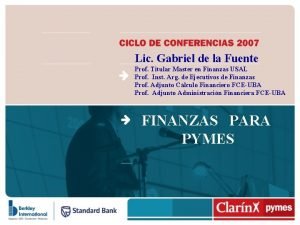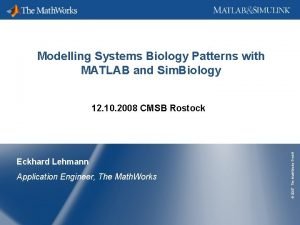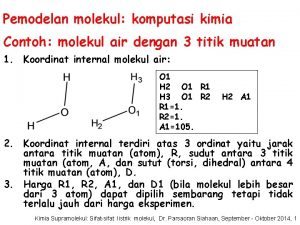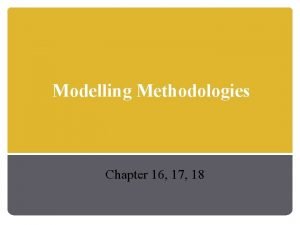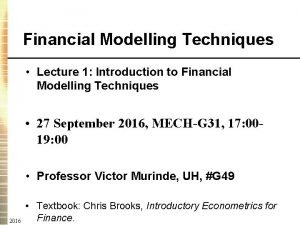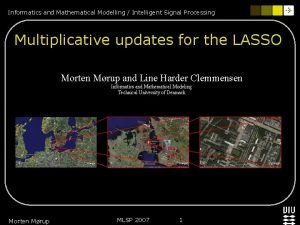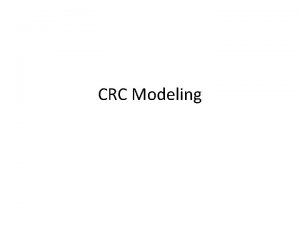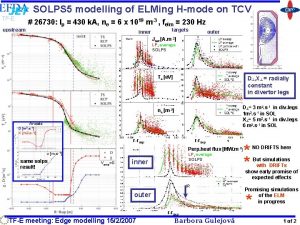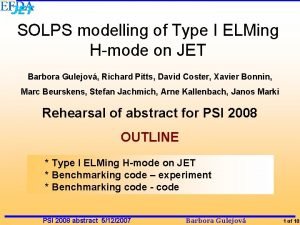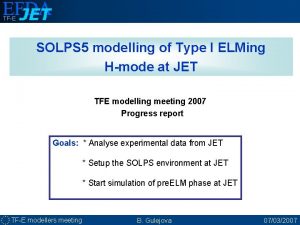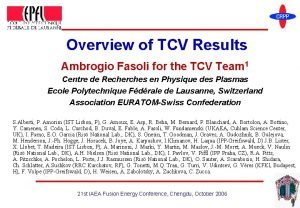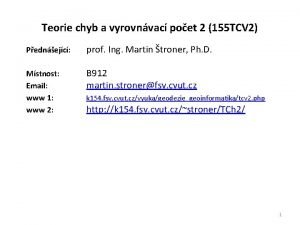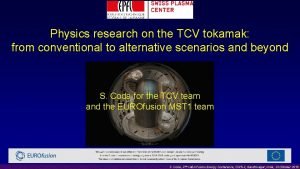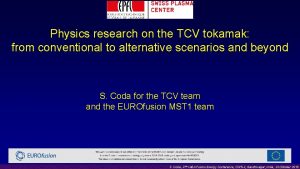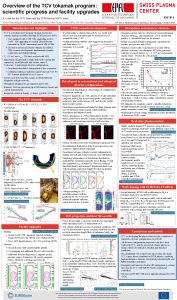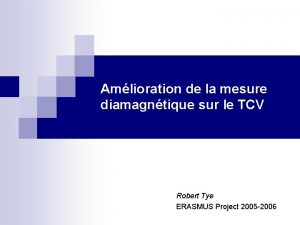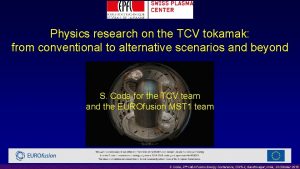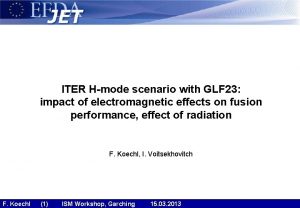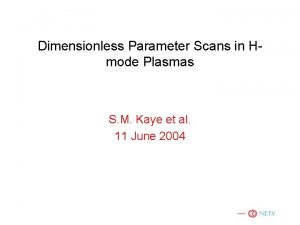Timedependent modelling of ELMing Hmode at TCV with














![ELM-time-evolution of jsat at targets outer Jsat [A. m-2] inner Jsat [A. m-2] ELM ELM-time-evolution of jsat at targets outer Jsat [A. m-2] inner Jsat [A. m-2] ELM](https://slidetodoc.com/presentation_image_h/1aa7fbe98863980d9d7348e61f045da7/image-15.jpg)
![Timedependence of target Te, Ti SOLPS inner outer Te [e. V] Te is rising Timedependence of target Te, Ti SOLPS inner outer Te [e. V] Te is rising](https://slidetodoc.com/presentation_image_h/1aa7fbe98863980d9d7348e61f045da7/image-16.jpg)



- Slides: 19

Time-dependent modelling of ELMing H-mode at TCV with SOLPS Barbora Gulejová, Richard Pitts, Xavier Bonnin, David Coster, Roland Behn, Jan Horáček, Janos Marki OUTLINE * SOLPS code package * ELM simulation – theory * Simulation of the ELM * Comparison of SOLPS with experiment EPS 2007 material 20/6/2007 Barbora Gulejová 1 of 2

Scrape-Off Layer Plasma Simulation Suite of codes to simulate transport in edge plasma of tokamaks B 2 - solves 2 D multi-species fluid equations on a grid given from magnetic equilibrium EIRENE - kinetic transport code for neutrals based on Mesh Monte - Carlo algorithm SOLPS 5 – coupled EIRENE + B 2. 5 B 2 plasma background => recycling fluxes EIRENE Sources and sinks due to neutrals and molecules measured Main inputs: magnetic equilibrium Psol = Pheat – Pradcore upstream separatrix density ne 72 grid cells poloidally along separatrix 24 cells radially systematically adjusted Free parameters: cross-field transport coefficients (D┴, ┴, v┴) EPS 2007 material 20/6/2007 Barbora Gulejová 2 of 2

Edge localised mode (ELM) H-mode Edge MHD instabilities Periodic bursts of particles and energy into the SOL - leaves edge pedestal region in the form of a helical filamentary structure localised in the outboard midplane region of the poloidal cross-section divertor targets and main walls erosion HFS first wall power deposition Dα LFS ELMing H-mode=baseline ITER scenario Energy stored in ELMs: TCV 500 J JET 200 k. J ITER 8 -14 MJ => unacceptable => W~600 J Small ELMs on TCV – same phenomena ! => Used to study SOL transport EPS 2007 material 20/6/2007 Barbora Gulejová 3 of 2

Type III Elming H-mode at TCV Ip = 430 k. A, ne = 6 x 1019 m-3 , felm = 230 Hz # 26730 ELMs - too rapid (frequency ~ 200 Hz) for comparison on an individual ELM basis => Many similar events are coherently averaged inside the interval with reasonably periodic elms telm ~ 100 μs tpre ~ 2 ms tpost ~ 1 ms Pre-ELM phase = steady state ELM = particles and heat are thrown into SOL ( elevated cross-field transport coefficients) Post-ELM phase EPS 2007 material 20/6/2007 Barbora Gulejová 4 of 2

Simulation of pre-ELM = steady state of H-mode presented at PSI 17, Hefei, China and published in JNM May 2006 upstream inner targets D┴, Χ┴ = radially constant in divertor legs outer Jsat [A. m-2] LP, average SOLPS D┴= 3 m 2. s-1 in div. legs 1 m 2. s-1 in SOL Χ┴= 5 m 2. s-1 in div. legs 6 m 2. s-1 in SOL Te [e. V] * * NO DRIFTS here But simulations with DRIFTs show early promise of expected effects ne [m-3] Very good overall match Ansatz D [m 2. s-1] Χ [m 2. s-1] r-rsep Perp. heat flux [MW. m-2] v [m. s-1] same solps result! Vperp=0 LP, average SOLPS inner IR outer r-rsep EPS 2007 material 20/6/2007 Good basis for time-dependent ELM simulation <=> * * Barbora Gulejová Pre-ELM must be time-dependent too! + equal time-steps for kinetic and fluid parts of code ~ 10 -6 s 5 of 2

Simulation of ELM * Instantaneous increase of the cross-field transport parameters D , ┴ ┴, v┴! 1. ) for ELM time – from experiment coh. averaged ELM = t. ELM = 10 -4 s 2. ) at poloidal location -> expelled from area AELM at LFS From the cross-field radial transport can be estimated the combination of transport parameters corresponding to the given expelled energy WELM, t. ELM and AELM Dα Many different approaches possible => changes in D┴, ┴ only or in v┴ too … W~600 J time AELM= 1. 5 m 2 * W = 600 J D┴ Diff. [e. V. m-2. s-1] D┴ ┴ EPS 2007 material 20/6/2007 Conv. [e. V. m-2. s-1] Barbora Gulejová 6 of 2

Tools to simulate ELM in SOLPS Several options in SOLPS transport inputfiles : * Multiplying of the transport coefficients in the specified poloidal region * In 3 different radial regions (core, pedestal, SOL) by different multipliers Added new options: * Poloidal variation of the multiplicator * Step function * Gaussian function * Choosing completely different shape of main SOL ELM radial profile for chosen poloidal region Inner div. leg No TB main SOL ELM x. M preelm core pedestal outer div. leg wall EPS 2007 material 20/6/2007 Barbora Gulejová 7 of 2

Simulation of ELM Experimental data to constrain the code: * Energy expelled by the ELM through separatrix (DML) ~ 600 J * Time of ELM-rise (D coavelm) ~ 100 μs * Jsat at the targets * Heat flux at outer target (IR soon) * Upstream ne, Te (TS) -> just orientation EPS 2007 material 20/6/2007 Barbora Gulejová 8 of 2

Simulation of ELM - results D, Chi (ELM): Same shape as pre. ELM Upstream profiles => TB, Just multiplied D x 100, Chi x 8 D, Chi (ELM): smaller TB + Gaussian function poloidally D, Chi increased only locally ! ne [m-3] Te [e. V] r-rsep EPS 2007 material 20/6/2007 r-rsep Barbora Gulejová 9 of 2

Comparison with TS – R. Behn Time evolution of D┴ and ne no TB TB D┴ t. ELM=100 µs ne time R-Rsep TS measurements (R. Behn) => * Drop in pedestal width and height appears only for ne SOLPS * bigger pedestal collaps * higher ne and Te in SOL But the right tendency – pedestal collapse + different ELMing H-mode shots ! no TB TB Te [e. V] R-Rsep EPS 2007 material 20/6/2007 Barbora Gulejová 10 of 2

Simulation of ELM - results D, Chi (ELM): Same shape as pre. ELM Target profiles => TB, Just multiplied D x 100, Chi x 8 targets “removal” of TB outer => inner higher values Jsat [A. m-2] at the targets SOLPS 27 pre. ELM 16 LP coav data 40 D, Chi (ELM): smaller TB + Gaussian function poloidally targets inner outer Jsat [A. m-2] SOLPS 30 pre. ELM 22 inner Te [e. V] Jsat [A. m-2] pre. ELM 35 ne [m-3] outer ne [m-3] Jsat [A. m-2] EPS 2007 material 20/6/2007 Barbora Gulejová 11 of 2

Simulation of ELM - results D, Chi (ELM) : Same shape as pre. ELM => TB, just multiplied D x 100, Chi x 8 D, Chi (ELM): smaller TB + Gaussian function poloidally inner 16 Target profiles – Heat fluxes outer inner 20 Like Jsat, Te, and ne, heat flux is higher for the case with smaller TB IR data available soon outer (J. Marki) Time-dep. heat flux estimated from LP measurements at outer target 9 R. Pitts, Nuc. Fusion 2003 EPS 2007 material 20/6/2007 Barbora Gulejová 12 of 2

ELM-Time evolution of jsat at targets outer target ELM LP 5 Dα pre-ELM post-ELM SOLPS Jsat [A. m-2] LP 20 SOLPS Inner R. Pitts, Nuc. Fusion 2003 EPS 2007 material 20/6/2007 Barbora Gulejová 13 of 2

ELM-Time-dependent solution at targets ELM inner outer TB during ELM midplane separatrix Jsat [A. m-2] ne [m-3] Te [e. V] Ti [e. V] time [s] EPS 2007 material 20/6/2007 time [s] Density is fixed at midplane separatrix => can’t change too much at the targets either => Jsat can increase mostly through Te, Ti => Necessary to increase D more then Chi in order to act on increase of ne Barbora Gulejová 14 of 2
![ELMtimeevolution of jsat at targets outer Jsat A m2 inner Jsat A m2 ELM ELM-time-evolution of jsat at targets outer Jsat [A. m-2] inner Jsat [A. m-2] ELM](https://slidetodoc.com/presentation_image_h/1aa7fbe98863980d9d7348e61f045da7/image-15.jpg)
ELM-time-evolution of jsat at targets outer Jsat [A. m-2] inner Jsat [A. m-2] ELM rise time LP 20 LP 5 Compared with LP close to strike point => Not exactly the same position SOLPS time [s] EPS 2007 material 20/6/2007 time [s] Barbora Gulejová 15 of 2
![Timedependence of target Te Ti SOLPS inner outer Te e V Te is rising Timedependence of target Te, Ti SOLPS inner outer Te [e. V] Te is rising](https://slidetodoc.com/presentation_image_h/1aa7fbe98863980d9d7348e61f045da7/image-16.jpg)
Timedependence of target Te, Ti SOLPS inner outer Te [e. V] Te is rising quicker then Ti Propagation down to the target from upstream pedestal Ti [e. V] Timedependence of simulated Te, Ti (D. Tskhakaya) for 120 k. J ELM at JET (sheat coeff assumed 8) R. Pittts, IAEA, 2006 EPS 2007 material 20/6/2007 Barbora Gulejová 16 of 2

Timedependence of target Te, Ti ELM ‘end’ inner SOLPS ELM ‘end’ outer peak Te [e. V] peak Ions are arriving to target later then electrons (~16 μs) In reality should be more, but : 1. ) probably more collisional 2. ) SOLPS – equipartition of energy between ions and electrons Ti [e. V] => reasonable shift of Te, Ti peaks R. Pittts, IAEA, 2006 EPS 2007 material 20/6/2007 Barbora Gulejová 17 of 2

Thank you for attention EPS 2007 material 20/6/2007 Barbora Gulejová 18 of 2

But not at strike point!! Probably more collisional EPS 2007 material 20/6/2007 Barbora Gulejová 19 of 2
 Tcc y tcv
Tcc y tcv Feature driven development template
Feature driven development template Building information modeling ppt download
Building information modeling ppt download Malatesta's modelling e.g. by mother
Malatesta's modelling e.g. by mother Data modelling
Data modelling Modelling madness
Modelling madness Sequence diagram penarikan uang di atm
Sequence diagram penarikan uang di atm Finshiksha financial modelling
Finshiksha financial modelling Edlc full form in embedded system
Edlc full form in embedded system Matlab biological modelling
Matlab biological modelling Molecular modelling laboratory
Molecular modelling laboratory Solid
Solid Define the relationship chapter 16
Define the relationship chapter 16 Financial modelling techniques
Financial modelling techniques Algorithmic cost modelling
Algorithmic cost modelling Modelling cost of delay
Modelling cost of delay Modelling
Modelling Which geometric modeling has ambiguous representation
Which geometric modeling has ambiguous representation Crc modelling
Crc modelling What is technological modelling
What is technological modelling
